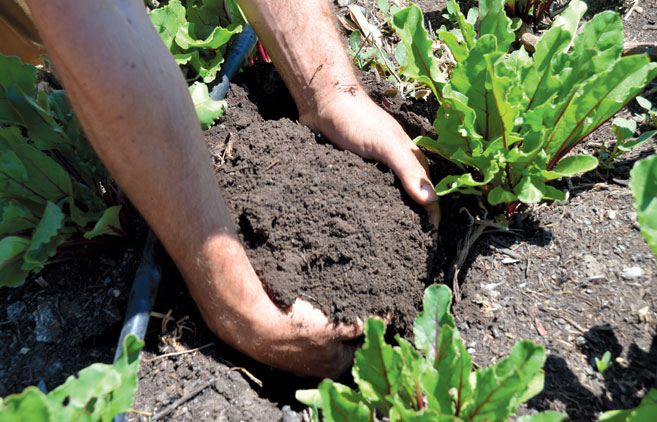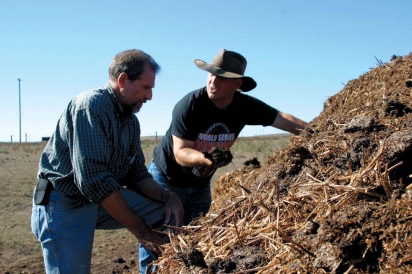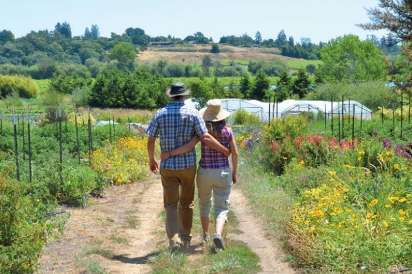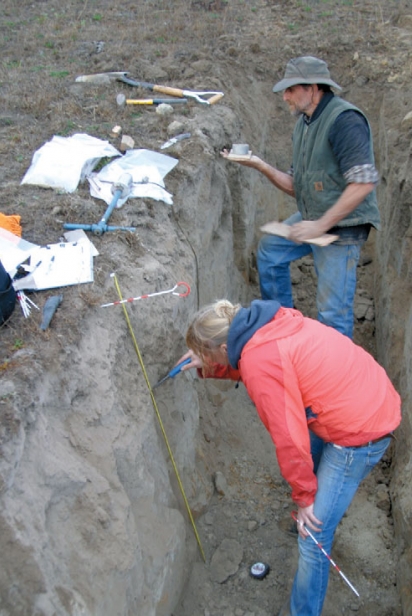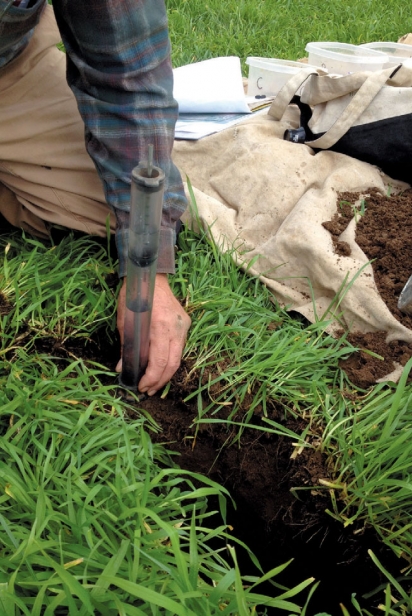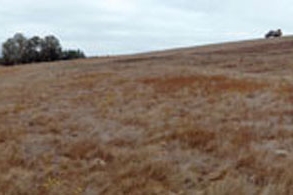Hope Under Our Feet: The Marin Carbon Project
Farming Carbon for the Future
When I first moved to Sonoma County over a decade ago, I didn’t give much thought to the knuckles of golden hills rising on either side as I drove home up the 101 corridor and through Two Rock Valley. These parched hills struck me as barren, idle space. But where some people see emptiness, others see gold.
In 2007, a small group of agriculturists sensed great potential in “them thar hills”—not to strike it rich, but with a much more noble and grand goal: reversing climate change. Guided by the question “How can agriculture engage proactively in the climate crisis?” the Marin Carbon Project was born. It quickly became a forerunner in demonstrating how agricultural soils can scrub carbon out of the atmosphere and store it away in the soil, reducing the concentration of the greenhouse gas carbon dioxide. The fact is, the world’s soils are perhaps the greatest remaining storage compartment—or “sink”—for atmospheric carbon.
John Wick and Peggy Rathmann’s Nicasio Native Grass Ranch became the pilot test site for the Marin Carbon Project. Wick spread compost—pure organic matter, about half of which is carbon—over their test site at the ranch and sat back to see what would happen.
Project co-founder Jeff Creque says they were amazed at the results: In the first six months, they measured significant increases in soil carbon, as well as the moisture content of the soil and plant productivity. “The important piece is that the increase in soil carbon was not from the compost, but from photosynthesis resulting from increased plant growth from the compost application,” says Creque.”This underscored something that should have been obvious from the beginning: If we could increase plant growth, we would increase carbon capture from the atmosphere.”
This boost in photosynthesis is the crux of carbon farming. Recall from high school biology class: photosynthesis is that immutable gesture of plants that takes in carbon dioxide (C02) and spits out oxygen (02), giving us clean air to breathe and taking only a carbon atom in payment. Amazingly, while plants and root systems store this acquired carbon, almost half of all carbon captured is passed on to the soil, in essence feeding it.
Carbon farming, simply put, is about managing land in ways that pull as much carbon from the air as possible into the soil as organic matter and storing it there for long periods of time. Carbon farming is quickly becoming a poster child of the climate fight. But can agriculture really pull enough carbon out of the atmosphere to meaningfully impact climate change?
A NEW HARVEST: CARBON
Farming has had a long and not altogether friendly relationship with the climate. In fact, agriculture is widely blamed as a big contributor to climate change—scientists say it is responsible for 12-14% of greenhouse gas emissions globally. While the biggest sources are livestock emissions and synthetic fertilizers, carbon lost from the soil also contributes. Renowned soil scientist Rattan Lal estimates that the world’s cultivated soils have lost more than half of their original carbon stock because of poor farming methods that disturb and degrade soils.
The good news is that there appears to be serious potential to reverse the trend. “We now understand that our landscapes in Marin, but also globally, have enormous potential to increase their carbon capture and storage,” says Creque. “With that understanding, when we do the math we realize that we could in fact have a significant impact on climate change if we were to change the way we manage our landscapes and begin to manage them for carbon capture.”
Eric Toensmeier, author of a forthcoming book about carbon farming, puts it this way: “When we talk about climate solutions and clean energy, we need to talk about carbon farming right alongside that, because if we switch to 100% clean energy today, we’re still over the tipping point; we’re still toast. And if we sequester all the carbon but don’t switch to clean energy, we’re also toast.”
Where California is concerned, Creque explains that a mere 1% increase in soil organic matter across California’s 46 million acres of rangeland, grasslands and arable lands would result in about 6.6 million acre feet of additional water holding capacity and the equivalent of 1.5 billion tons of CO2 sequestered.
These are impressive-sounding numbers, but what do they actually mean? I did some quick back-of-the-envelope calculations and was astounded to discover that implementing this small but widespread change would be the equivalent of taking 1.1 million cars off the road or replacing about 4 billion 60-watt light bulbs with compact fluorescents.
When I asked Toensmeier what it would actually take to increase soil carbon by 1%, he chuckled, saying, “There are lots and lots and lots of examples where people increased soil organic matter by far more than that in far worse conditions than California farmers face.” In his book, Toensmeier profiles 40 different techniques for building soil organic matter, covering annual and perennial crops, livestock production, the soil amendment biochar and rainwater harvesting.
While the emphasis in carbon farming is on sequestering carbon to offset climate change, proponents underscore that it solves many problems at once. Boosting carbon-rich organic matter also serves to retain substantial amounts of water, helping to ease the effects of both drought and flooding. Carbon farming also reduces erosion, enhances fertility and boosts crop yields.
Point Blue, a conservation science organization headquartered in Petaluma, is among those at the forefront of the carbon farming movement in the region. Through its Rangeland Watershed Initiative, Point Blue collaborates with the Natural Resources Conservation Service and local ranchers to build healthy soils for multiple benefits. Point Blue’s Working Lands Program Director Wendell Gilgert says, “If we treat the soil right, we get all we’re looking for—modification of drought, climate-smart management activities, restoration activities and more.”
Point Blue starts by eyeballing how much bare soil there is on a property and how much capacity the land has to produce more vegetation. Gilgert says they use a “one ounce—one inch” approach—just one more ounce of vegetation per square foot would enable the soil to hold one more inch of rainfall in the soil profile. In turn, this would provide about 2,700 more pounds of feed per acre, translating to real financial savings (particularly given the high cost of hay in the present drought) and significantly helping mitigate drought conditions. Gilgert’s team then supports the rancher in developing grazing management plans that include a broad set of carbon-building practices.
SINGING FROGS FARM: WHISTLING A DIFFERENT TUNE
Carbon farming is not limited to ranching. In fact, cropland typically has greater potential to sequester carbon on a per-acre basis. One of the leading innovators in this field nationally is Singing Frogs Farm in Sebastopol. Singing Frogs Farm is a small, diversified operation run by Elizabeth and Paul Kaiser. The couple grows 140 different crops on three cultivated acres in West Sonoma County. They market their products at five farmers’ markets, nine restaurants and a 130-member CSA, as well as through the wholesaler Feed Sonoma.
Researchers and fellow farmers alike are flocking to the Kaisers’ farm to learn how their approach has achieved mind-bending rates of carbon sequestration: The Kaisers have managed to increase their soil organic matter from 2.4% to an optimal 7-8% in just six years, an average increase of about 3/4 of a percentage point per year.
The Kaisers achieve this by dialing up to the extreme several core principles of sustainable agriculture. For example, they maximize photosynthesis by continually keeping plants in the ground, literally planting the next crop just a day or two after harvest. In this way, they are constantly “feeding the soil” with carbon by producing five to seven cycles of crops per year. The constant plant cover also serves to protect the soil from erosion and water loss, essentially taking over the role of mulch.
The Kaisers also add much more organic compost to their soils than the norm to improve fertility and water-holding capacity.
Singing Frogs Farm also takes great care not to disrupt the soil structure—this means no tillage. Tillage impacts the soil by breaking it down, degrading the soil and releasing valuable nutrients (carbon and nitrogen) into the air (incidentally, these get released into the air as the greenhouse gases nitrous oxide and carbon dioxide), and killing soil-building earthworms and microbes. Paul Kaiser warns that decades of soil building can be undone in a single season of tillage.
The results have been transformative. “When we started out, we were doing two to three hours of drip [irrigation] every other day... Now we are really pushing it. We’re down to about 20-30 minutes per week.” To illustrate the point, the Kaisers planted carrots this spring, which they hand-watered until they germinated, at which point they typically switch to drip irrigation. Paul says: “This year, we forgot to switch to drip. We came back six weeks later, and discovered that we had almost-ready-to-harvest carrots that we hadn’t watered in six weeks!”
CARBON FARMING THE NORTH BAY
While Singing Frogs Farm is unusual in the extreme to which they take these practices, a burgeoning community of local growers and ranchers is bringing soil health back to the center of farming.
Doug Lipton, a Sonoma County farmer and co-owner of SHED, Healdsburg’s popular market, cafe and gathering place, has always incorporated compost into the fields at his farm, but thanks to the restaurant, he is now able to provide his own. “Now, with SHED, I don’t haul in any outside material,” he says. “It’s all connected to SHED—all the waste I can’t feed to my chickens, I’ll throw in the compost.” Lipton also boosts carbon sequestration by planting arugula, salad greens and “green manure” crops between orchard rows, and experimenting with biodynamic sprays and compost teas.
More broadly, our entire Northbay region has a relatively high potential to increase carbon capture through photosynthesis. The area’s active and functional Resource Conservation Districts and other technical support agents, as well as its progressive agricultural community, promise to make it easy to scale up solutions.
David Lewis, who directs the Marin office of UC Cooperative Extension and has been a collaborator on the Marin Carbon Project, celebrates Marin’s leadership in setting up a legacy of preserved working landscapes that took place decades ago.
“At the time, we didn’t appreciate all the benefits that come back to the community from that early pioneering,” says Lewis. “I hope people appreciate that agriculture continues to be part of the solution, and that small and medium-scale family farms in Marin are a critical part of our community and are playing that role.”
Doug Lipton notices the way sustainable agriculture has brought new communities of people together, tying the farm community and the environmental community together, as well as the broader population. In the ‘60s and ‘70s, “it was the hippies and back-to-the-landers who would appreciate compost and soils. Now, probably because of the food movement and knowledge that good food comes from good farms, soil has moved beyond being appreciated by narrow sector of population to a much larger group that includes the Millennial who enjoy wine country.”
A WATERSHED MOMENT FOR CARBON FARMING
This is a particularly exciting time for sustainable agriculture in California in other ways. For the first time, farmers are beginning to be recognized financially for the benefits they provide to society by farming carbon. According to Renata Brillinger, executive director of the California Climate and Agriculture Network, “we’re really poised to be the first state in the country and possibly in the world that is going to figure out how to invest cap-and-trade funds and incentivize voluntary farming practices, things growers might want to try but are risky.”
Last year, the carbon offset program American Carbon Registry (ACR) adopted a way to compensate ranchers for applying compost to grazed grasslands that was developed by the Marin Carbon Project and its collaborators. The California Department of Food and Agriculture recently launched the Healthy Soils Initiative, which has proposed a $20 million set aside in this year’s budget to pay farmers and ranchers for practices that sequester carbon, such as applying compost and planting cover crops and trees. Two bills currently in the legislature, AB 761 (Levine) and SB 367 (Wolk), would expand this support as well as the range of practices that qualify for funding.
The California legislature is in the final stages of creating even more ambitious greenhouse gas reduction targets for 2050. “We think we can’t achieve those goals unless we involve these really unique and potentially powerful agricultural solutions,” says Brillinger.
BLACK IS THE NEW GREEN
Realizing the potential of carbon farming is not without major hurdles. For example, the local availability of compost, the application of which is one of the most effective ways of quickly boosting soil health, has just been made very difficult by the forced closure of the company Sonoma Compost over water quality concerns at its facility. The closure is “highly significant and couldn’t come at a worse time,” says Jeff Creque. “The importance of compost is finally being recognized and we are having legislation passed that requires the increased diversion of organic waste from landfills. To be closing the preeminent compost facility is nuts.”
Yet in spite of the obstacles, there is much to be hopeful about. The capacity of nature to heal itself, for healthy agro-ecosystems to temper climate change, is truly humbling. There is no doubt that the founders of the Marin Carbon Project were on to something significant when they looked up into the hills and saw its golden potential. And in the process, they inspired, in me at least, not only a fresh way of seeing, but a deeper connection to the place I call home.
Natural Resources Conservation Service—NRCS.gov/wps/portal/NRCS/site/national/home


